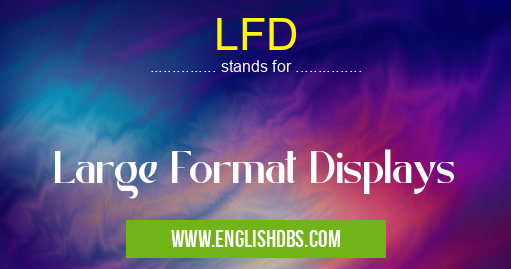What does LFD mean in UNCLASSIFIED
LFD stands for Large Format Displays. These are electronic display panels that are significantly larger than standard monitors, ranging from 32 inches to over 100 inches in diagonal size. LFDs are commonly used for various applications, including:

LFD meaning in Unclassified in Miscellaneous
LFD mostly used in an acronym Unclassified in Category Miscellaneous that means Large Format Displays
Shorthand: LFD,
Full Form: Large Format Displays
For more information of "Large Format Displays", see the section below.
- Digital signage
- Video conferencing
- Presentations
- Retail displays
- Hospitality
Meaning of LFD in MISCELLANEOUS
In the context of MISCELLANEOUS, LFD refers to the use of large format displays in miscellaneous settings or applications. This could include:
- Museums and exhibitions: LFDs can be used to display high-resolution images, videos, and interactive content in museums and exhibitions.
- Events and conferences: LFDs are often used for live presentations, keynote speeches, and product demonstrations at events and conferences.
- Retail stores: LFDs can be used to display product information, promotional materials, and interactive experiences in retail stores.
- Transportation hubs: LFDs can provide information, entertainment, and advertising content in transportation hubs such as airports and train stations.
Essential Questions and Answers on Large Format Displays in "MISCELLANEOUS»UNFILED"
What are Large Format Displays (LFDs)?
Large Format Displays (LFDs) are digital displays that typically measure over 32 inches diagonally. They are designed for commercial use in various applications, such as digital signage, video conferencing, and advertising.
What are the benefits of using LFDs?
LFDs offer several benefits, including:
- High visibility and impact due to their large size and bright displays.
- Enhanced user engagement and interaction through touchscreens and interactive features.
- Versatility for a wide range of applications, including retail, hospitality, education, and healthcare.
- Cost-effective and energy-efficient compared to traditional signage methods.
What are the different types of LFDs?
LFDs come in various types, including:
- LCD (Liquid Crystal Display): Uses liquid crystals to produce images.
- LED (Light-Emitting Diode): Uses light-emitting diodes for brighter and more energy-efficient displays.
- OLED (Organic Light-Emitting Diode): Uses organic materials for flexible and ultra-thin displays.
- Touchscreen LFDs: Allow users to interact with the display through touch.
How do I choose the right LFD for my needs?
Consider the following factors when choosing an LFD:
- Size: Determine the appropriate screen size based on the viewing distance and application.
- Resolution: Choose a display with a high resolution for clear and sharp images.
- Brightness: Select a display with sufficient brightness for the intended environment.
- Connectivity: Ensure the display supports the necessary connectivity options, such as HDMI, DisplayPort, and USB.
- Features: Consider additional features like touchscreens, built-in speakers, and content management systems.
How do I install and maintain an LFD?
LFD installation and maintenance should be handled by qualified professionals.
- Installation: Mount the display securely and ensure proper ventilation.
- Maintenance: Regularly clean the display, check connections, and update software to maintain optimal performance.
Final Words: LFDs offer a unique combination of size, resolution, and interactivity, making them ideal for a wide range of applications in MISCELLANEOUS settings. They can enhance the user experience, provide engaging content, and deliver effective communication in various environments.
